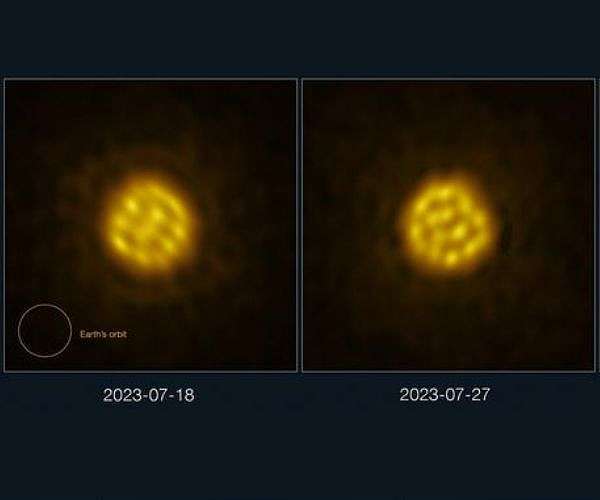16.09.2024

Astronomers have captured a sequence of images of a star other than the Sun in enough detail to track the motion of bubbling gas on its surface. The images of the star, R Doradus, were obtained with the Atacama Large Millimeter/submillimeter Array (ALMA), a telescope co-owned by ESO, in July and August 2023. This panel shows three of these real images, taken with ALMA on 18 July, 27 July and 2 August 2023. The giant bubbles - 75 times the size of the Sun - seen on the star's surface are the result of convection motions inside the star. The size of the Earth's orbit is shown for scale.
For the first time, astronomers have captured highly detailed images of a star, other than our Sun, that reveal the movement of bubbling gas on its surface. These observations were made using the Atacama Large Millimeter/submillimeter Array (ALMA) in July and August 2023. The star, R Doradus, is located around 180 light-years away from Earth in the constellation Dorado. The images show enormous, hot bubbles of gas - 75 times the size of our Sun - appearing on the star's surface before sinking back into its interior at a faster pace than previously expected.
"This is the first time the bubbling surface of a real star can be shown in such a way," said Wouter Vlemmings, a professor at Chalmers University of Technology, Sweden, and lead author of the study published in 'Nature'. "We had never expected the data to be of such high quality that we could see so many details of the convection on the stellar surface."
Stars generate energy in their cores via nuclear fusion, which results in hot gas bubbles moving towards the surface. As these bubbles cool, they sink back into the star's interior. This process, called convection, spreads heavy elements like carbon and nitrogen throughout the star and contributes to stellar winds that eventually carry these elements into space, fueling the creation of new stars and planets.
Until now, scientists had never been able to track the convection motions in stars other than the Sun in such detail. With ALMA's high-resolution imaging, the team observed the surface of R Doradus for a month, capturing unprecedented details. The star, a red giant with a diameter about 350 times that of the Sun, is similar in mass to the Sun and offers a glimpse of what our own star might look like in five billion years when it evolves into a red giant.
"Convection creates the beautiful granular structure seen on the surface of our Sun, but it is hard to see on other stars," added Theo Khouri, a researcher at Chalmers and co-author of the study. "With ALMA, we have now been able to not only directly see convective granules - 75 times the size of our Sun - but also measure their speed for the first time."
The observations revealed that the granules on R Doradus cycle on a monthly basis, which is faster than expected based on models of convection in the Sun. "We don't yet know what is the reason for the difference. It seems that convection changes as a star gets older in ways that we don't yet understand," explained Vlemmings. These findings are helping astronomers better understand the behavior of stars like the Sun as they age and evolve into red giants.
"It is spectacular that we can now directly image the details on the surface of stars so far away and observe physics that until now was mostly only observable in our Sun," concluded Behzad Bojnodi Arbab, a PhD student at Chalmers involved in the study.
Quelle: SD
